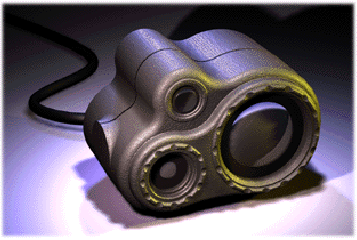| Laser Safety Class |
Class I (fully eye safe) [FDA] |
| Beam Divergence |
5.6 mrad [1/3Ÿ] |
| Wavelength |
905 nm [near infrared] |
| Pulse Rate |
1200 Hz. |
| Operating Range |
.3-30 m (1-100 ft.), 20% surface - non-cooperative target(1) |
|
1-100m (1-330 ft.), 90% surface - White Wall(1) |
|
1-300m (1-1000 ft.), Plastic Reflector |
| Accuracy over Temperature Range |
<1 cm (.4 in.) typical |
|
2.5 cm (1 in.) absolute (2) |
| Resolution over Temperature Range |
1mm (0.04 in.) (2) |
| Accuracy, single shot |
+/- 1.5 in. |
| Repeatability |
5 mm [.2 in] |
| Measurement Rate |
5-1200 Hz |
| Accuracy, integrated |
+/- 1.5 in. divided by the sqr root of samples[1-256] |
| Computer Interface |
Bi-directional RS-232 @ 19.2 kBaud |
| Analog Output |
4-20 mA |
| Power Requirement |
10-28 Vdc, 7 W max. |
| Rating |
UL, CSA, EC |
| Storage Temperature |
-20Ÿ to +60Ÿ C |
| Operating Temperature |
0Ÿ to + 35Ÿ C currently (-10Ÿ to +50Ÿ C soon) |
| Humidity |
0-95%, non-condensing |
| Enclosure Rating |
NEMA 6 |
| Size (approximate) |
105mm (4.125 in.) H x 152mm (6.0 in.) W |
|
x 108mm (4.25 in.) D |
| Weight |
1.5 kg (3.3 lbs.) |
| Mounting |
bottom and/or sides tri-pod threaded std. mt. |
| Standard Accessories |
|
| 1. |
Built in sighting scope |
| 2. |
AC/DC power adapter with connector |
| 3. |
RS-232 serial cable (6') |
| 4. |
User Manual |
| 5. |
User Software (Windows 95) |
| Optional Accessories |
|
| 1. |
Power Cable with connector |
| 2. |
Mountable 3" plastic reflectors |
| 3. |
RS-485 serial interface upgrade |
| 4. |
57.6K baud upgrade |
| 5. |
Increased pulse rate to 9600 Hz(3) |
| DATA INTERFACE |
|
| J1 - RS-232 Connector - 9 Pin, Serial |
|
|
J2 - Power (+6 to +30 Vdc) Connector |
| J1-1 Not Connected |
|
| J1-2 Data Out (RS-232 XMT) |
J2-1 Power Input -- Outer |
| J1-3 Data In (RS-232 RCV) |
J2-2 Power Ground -- Inner |
| J1-4 Not Connected |
|
| J1-5 RS-232 CTS |
J3 - Analog Signal(4-20 mA) Connector |
| J1-6 Not Connected |
|
| J1-7 RS-232 RTS |
J3-1 Analog Ground -- Outer |
| J1-8 Not Connected |
J3-2 Analog Signal -- Inner |
| J1-9 Signal Ground |
|





























